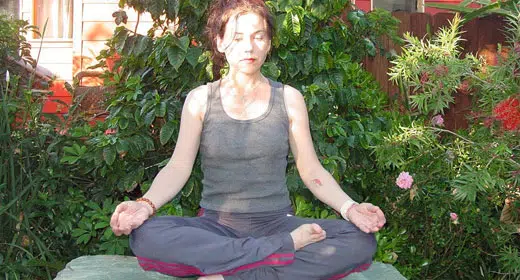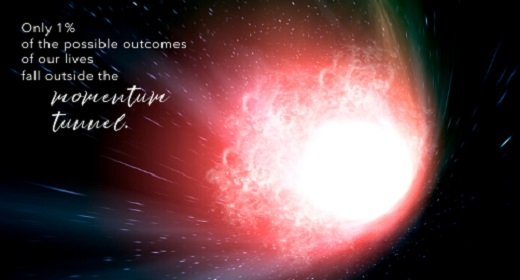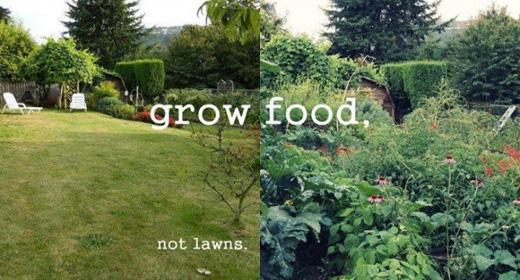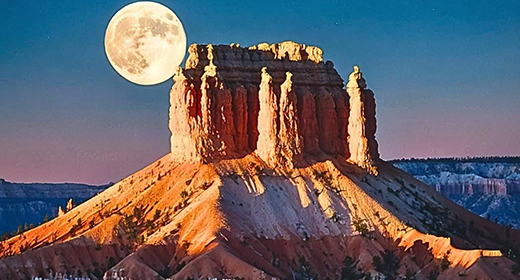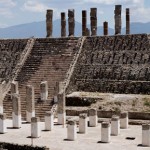by Karen Bouris: The founder and abbot of Upaya Zen Center in Santa Fe, New Mexico, Roshi Joan Halifax has been a socially active leader in Buddhism for more than 40 years

—as a civil rights activist, ecologist, and advocate for caregivers and the dying. An anthropologist who lived with and studied the Dogon people in Mali in her 20s, Halifax has also studied and written about shamanism. Born in Hanover, New Hampshire, in 1942, Halifax has said her journey toward Buddhism began at age four, when she was stricken with a virus that left her legally blind for two years.
When you got sick, would you say that that was the beginning of your understanding of suffering and the development of your compassion?
I look on the sickness as a sort of a dream now—it was long time ago. I look on it, really, as a blessing. I think I was introduced to my inner life as a result. I don’t think I characterized it as suffering. In retrospect, I look on the experience with wonder—I have two eyes now, and I can see. I have that feeling of gratitude.
But my mother was a very compassionate person. She was a volunteer during the Second World War at a hospital for veterans. My grandmother was also incredibly compassionate. I think of my interest or capacity to work in difficult situations as something that I “caught” from my mother, my grandmother, and the women who took care of me.
This discovery of your inner life during your illness as a child, is that what led you to study shamanism?
I was much more involved with Buddhism before I got interested in shamanism. But I was an anthropologist, so I had an opportunity to spend time with indigenous cultures. I discovered the world of shamans, which can be characterized by encounters with a lot of suffering—the idea of a wound healer, which is typical for many shamans. Not all, but many. I became fascinated with that model. It was about looking at how a breakdown can actually create the conditions for robustness. In the case of the shaman, a healer can emerge, or any living system can become more robust, as a result of a breakdown. It made sense to me in terms of how we could reappraise the nature of suffering, not seeing it as such a victim’s story, but rather as an opportunity.
You’ve talked also about how both Buddhism and shamanism focus on direct experience instead of doctrine.
In Buddhism, the feeling that one gets from the early sutras is that it’s more anecdotal, less list oriented. The Buddha teaches how important it is to have a direct experience that arises from practice. And that certainly is true as well of shamanism: that realization happens in the context of practice, not just reading a book or hearing about it.
Does that idea lead into Engaged Buddhism?
It does in a way. Engaged Buddhism is about the application of the Buddhist ethos in the context of suffering, whether it’s institutional suffering or individual suffering. So,
yes, it’s where the rubber meets the road. How do we actualize the spirit of the bodhisattva, the compassionate dimension in our lives, in a direct, practical way? A lot of my work was really motivated by injustice. And then when I began to work with dying people, I saw the incredible value in being of service directly to people who are suffering.
But my work in end-of-life care has not only been with individual people who are dying and their families; it’s also been directed toward the question of, How can we transform the culture of medicine, which is afflicted by institutional suffering?
To be sure, I wouldn’t be alive today but for Western medicine, so it’s not throwing the baby out with the bathwater, but it’s about looking at what causes clinicians to suffer—things like moral distress, secondary trauma, structural violence, horizontal hostility, and burnout—and looking at transforming the conditions that make it difficult for clinicians to sustain compassion.
When you were doing hospice work, how did you see the experience of death and dying affect caregivers?
All of us are going to die, and there’s no getting around it. Death is inevitable, and the issue of our mortality opens us up to very profound levels of experience.
And yet, often people take the really hard road to death. Even when dying people are beautifully cared for, it doesn’t mean that it’s going to be easy. In my own experience, I got into a space of acceptance not only that dying is a release but also that it can be tough. I learned to accept the unacceptable. So the practice, for me, is about creating the kind of resilience or buoyancy where you can be present to bear witness to the truth of suffering.
Sometimes I kid myself and say, I hope I don’t fail the test. I could have a difficult death, too—anybody could. We just don’t know. But what we try to do to prepare for dying is to develop the qualities of the mind that allow us to be with whatever is arising.
I have heard you express outrage and despair over violence and our treatment of the environment. Can you talk about outrage and what people can do with it?
I think that moral outrage is not a bad thing, but you have to understand that if you get in too outraged a state, then you go into distress, and that has outcomes which are not wholesome. On the other side of the equation, it can fuel you to move forward in terms of taking action.
In terms of the earth—wow. In the ’60s we were worried, but we really had no idea. When you are removing mountaintops, and turning rivers into poison, and extinguishing the life of species—I just want to know what we are leaving for our children. It’s just inconceivable to me, how we’re fouling the nest.
And it’s not only that, but the whole world is taking on our value system and our patterns of consumption. That’s one of the issues
that really concern me—how we have transmitted our values to indigenous peoples around the world.
But I also travel, so I am consuming jet fuel as I move around the world teaching. I am very aware of that.
If people who care about the environment have such a hard time making decisions that are environmentally benign, then it’s pretty bad news.
You know, I feel caught in this paradox—doing the amount of traveling and teaching that I do, and then I tell people not to travel, not to consume jet fuel and so on. A lot of my life is really simple, but I am fairly aware of where I am contributing to the problem. But I try to bring that into my own personal focus, so I can take responsibility in other ways.
Switching gears, the Dalai Lama has said in the last few years that he would love if a woman was named the next Dalai Lama. Yet I can’t help but observe, as an outsider, the lack of women in Buddhism and, of course, in most organized religions. So, I love that he’s saying that, but I also wonder what you think about that?
I don’t think the Dalai Lama’s main issue has to do with gender parity. I think he is primarily focused on three things: Tibet, science, and interfaith issues. I have heard him often speak positively about gender parity, but it’s not an issue that he seems to have put on the table actively in his life. However, there are great teachers who are actively working toward gender parity, so I feel it is going to be normalized in the next generation.
And by the way, gender bias is not only in Tibetan Buddhism; it’s in Japanese Buddhism, it’s in the entire modern world, and it’s global. So, those of us who are in our 60s and 70s and 80s who worked for gender parity and really pushed on that issue, we are seeing some resolution, but we are not there yet. It’s coming, and we are still dedicated.
One of our readers asks: “I would like to know how, if one has a life of chronic stress, like being a parent of a special needs child, how one deals with the sorrow, guilt, and loss, and how one can cultivate a center of peace.”
I don’t have children, so it’s always a stretch for me to speak with integrity to a parent. But I think it’s important to have a practice, to have a way to refresh your own mind and heart. I also think it’s important to set it up so there can be more collaboration in the caregiving. Doing it as a lone ranger is really not sustainable. It’s not good for you; it’s not good for whoever is being taken care of.
I also think it is important to reappraise one’s position. In other words, we often feel, somehow, through this archetype of self-sacrifice, that we are gaining merit by martyring ourselves instead of seeking the collaborative help that we really need.
This self-harming on behalf of another is called pathological altruism. That’s kind of a hard term, but I think it is important to positively appraise what we do and also positively appraise our in-breaths and have respect for our own well-being.
Another reader asks: “What is one of your favorite practices?”
I think a favorite practice is tonglen. It works for me as practitioner. I don’t know if it benefits anybody else, but in teaching it to caregivers over many years, I think it is one of those practices that have given the most to people who give care.
Can you look through your anthropologist lens and tell us what you think religion and spirituality will look like in a hundred years?
I have no idea. I have been fascinated with the advent of Buddhism in the West, because between democracy, psychology, and feminism, and also that deep care of families, Buddhism has gone through quite a radical transformation.
I think one of the things that are going to influence how religion and spirituality unfolds in the future is technology. I had no idea in the ’60s that today I would have students all over the world whom I can be in touch with on a virtual level. And we can be in the Vatican seeing that white or black smoke, or we can see Thich Nhat Hanh in Vietnam. And it’s happened so rapidly. But, I also think our brain architecture is changing in relation to technology, and that’s going to change our practices as well.
Tonglen: Compassionate Meditation
The Tibetan practice of tonglen or “sending and receiving,” is a meditation to ease suffering.
To practice tonglen, imagine yourself breathing in the hurt, fear, or pain of the person who is suffering; then as you breathe out, visualize yourself sending that person warmth, happiness, and relief from their pain.
“It seems counterintuitive that one would bring in the suffering and let this experience break our heart open to its true nature of vastness, boundlessness, so the hardness of suffering can dissolve into who we really are,” says Joan Halifax. “And the next exhale from this space is of mercy, loving kindness, pure coolness toward the one who is suffering.”

